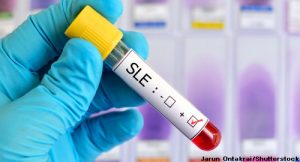 Disease flares in patients with systemic lupus erythematosus (SLE) impede quality of life and decrease long-term survival. Although researchers know alterations in cellular profiles are associated with SLE disease activity and immune dysregulation, the revealed dysregulation is complex, making it difficult to characterize the pathways associated with imminent clinical flares. Recent results suggest SLE flares arise from two mechanisms that, in some patients, overlap. One mechanism is primarily lymphoid, and the other is primarily myeloid. Rufei Lu, MD, PhD, a postdoctoral fellow at the Oklahoma Medical Research Foundation, Oklahoma City, and colleagues published their findings online June 13 in Scientific Reports.1
Disease flares in patients with systemic lupus erythematosus (SLE) impede quality of life and decrease long-term survival. Although researchers know alterations in cellular profiles are associated with SLE disease activity and immune dysregulation, the revealed dysregulation is complex, making it difficult to characterize the pathways associated with imminent clinical flares. Recent results suggest SLE flares arise from two mechanisms that, in some patients, overlap. One mechanism is primarily lymphoid, and the other is primarily myeloid. Rufei Lu, MD, PhD, a postdoctoral fellow at the Oklahoma Medical Research Foundation, Oklahoma City, and colleagues published their findings online June 13 in Scientific Reports.1
The investigators sought to determine the immune variables that distinguish SLE patients who experience rapid flare after transient corticosteroid-induced disease suppression from those who experience flare later. The researchers focused their study on patients who had active, but not organ threatening, SLE at baseline. These patients provided baseline samples the investigators used to identify patients who experienced clinically significant improvements after receiving one to four bolus depomedrol injections to suppress disease, but then flared. Flares occurred early, within 60 days of baseline, in 21 patients and late, 90–165 days post-baseline, in 13 patients.
Previous studies have identified transcriptional models associated with immune modulation. The researchers used these modules to analyze the baseline samples. They compared the results from patients who flared early to those from patients who flared late to see if there was a pattern that distinguished the groups. They found, at baseline, the patients who would flare early had differential gene expression in monocyte, T cell, interferon and other inflammation modules when compared to those who flared later. The investigators then measured baseline levels of 32 cytokines, chemokines, adhesion molecules and soluble tumor necrosis factor receptors.
The researchers ran all the data through random forest models to determine the handful of variables most informative as independent predictors of flares. They found the model based on cellular phenotype (n=30) had a reliability of 86.4 ± 1.4% accuracy. The next most accurate model was based on complement C3 levels and had an accuracy of 79.31 ± 0.01%. However, the most accurate model overall was based on increases in aCD11b+ monocytes and CD86hi naive B cells and had an accuracy of 88.67 ± 2.69%.
Although all SLE patients had elevated interferon modules relative to healthy controls, patients who went on to early flare fell into one of three subsets. In one patient subset, early flares were preceded by high frequencies of activated (aCD11b+) monocytes, elevated monocyte module scores and decreased plasma concentration of the CD11b receptor ICAM-1. The second patient subset had elevated frequencies of activated CD86hi/CD19+/CD27-naive B cells, as well as increased B cell module scores. The third patient subset had both patterns.

